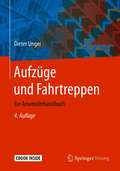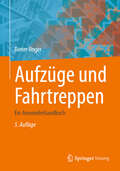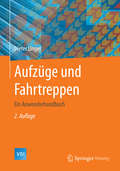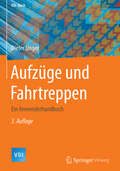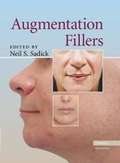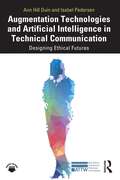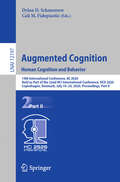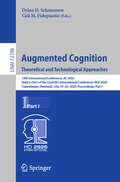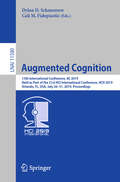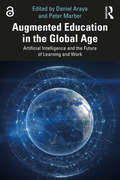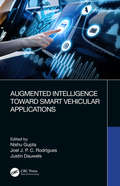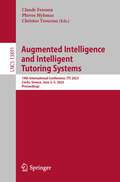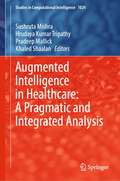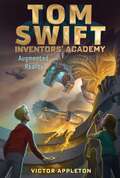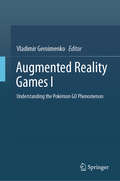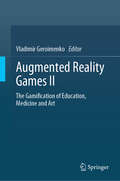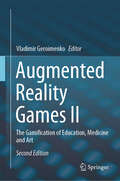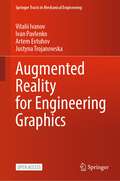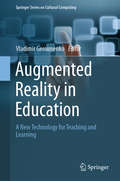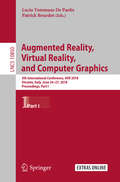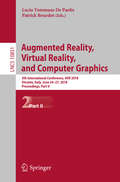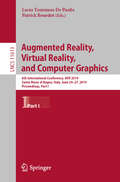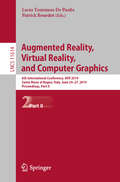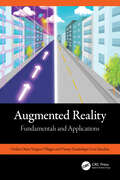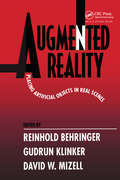- Table View
- List View
Aufzüge und Fahrtreppen: Ein Anwenderhandbuch
by Dieter UngerIn der aktuellen Auflage bietet dieses Fachbuch für alle, die Fahrtreppen und Aufzüge planen, bauen oder betreiben, einen umfassenden Überblick zu allen wichtigen Fragen: angefangen bei den Normen und technischen Regeln bis hin zur Technikgeschichte. Es werden Planung, Betrieb, Wartung und Dokumentation von Aufzügen und Fahrtreppen beschrieben. Zahlreiche aussagekräftige farbige Abbildungen ergänzen den Text. Für die vierte Auflage wurden die Kapitel zu nationalen und internationalen Richtlinien auf den aktuellen Stand gebracht. Sie wurden neu strukturiert und weitere ISO Normen aufgenommen.Das Buch dient Betreibern von Aufzügen und Fahrtreppen als Nachschlagewerk. Die vielen Beispiele, Tipps und Ratschläge aus der Praxis machen es zu einem hilfreichen Begleiter bei der täglichen Arbeit.
Aufzüge und Fahrtreppen: Ein Anwenderhandbuch
by Dieter UngerDieses Fachbuch bietet allen, die Fahrtreppen und Aufzüge planen, bauen oder betreiben, einen umfassenden Überblick zu allen relevanten Themen, angefangen bei den Normen und technischen Regeln bis hin zur Technik. Es werden Planung, Betrieb, Wartung und Dokumentation beschrieben und mit zahlreichen aussagekräftigen Abbildungen ergänzt. Die vorliegende Auflage wurde in einigen Kapiteln angepasst, insbesondere die Kapitel Normen und Richtlinien wurden aktualisiert und erweitert.Das Buch dient Betreibern von Aufzügen und Fahrtreppen als Nachschlagewerk. Die vielen Beispiele, Tipps und Ratschläge aus der Praxis machen es für Ingenieure, Techniker und Architekten zu einem hilfreichen Begleiter bei der täglichen Arbeit.
Aufzüge und Fahrtreppen: Ein Anwenderhandbuch (VDI-Buch)
by Dieter UngerDas umfassende Nachschlagewerk bietet einen herstellerübergreifenden Überblick zu Planung und Betrieb von Aufzügen und Fahrtreppen. Es gibt eine schnelle Übersicht der grundlegenden Normen und technischen Regelwerke. Diese werden mit zahlreichen Beispielen aus der Praxis erläutert. Mit wichtigen Tipps und konkreten Ratschlägen, die direkt in ihre tägliche Arbeit einfließen können, richtet sich das Buch an Ingenieure und Techniker auf dem Gebiet der Fördertechnik sowie die Betreiber solcher Anlagen.
Aufzüge und Fahrtreppen: Ein Anwenderhandbuch (VDI-Buch)
by Dieter UngerFür alle, die Fahrtreppen und Aufzüge planen, bauen oder betreiben, bietet das Buch einen umfassenden Überblick zu allen wichtigen Fragen: angefangen bei den Normen und technischen Regeln bis hin zu Einblicken in die Technikgeschichte. Der Autor behandelt Planung, Betrieb, Wartung und Dokumentation von Aufzügen und Fahrtreppen. Dabei kommen verschiedene Aufzugsarten wie zum Beispiel Bauaufzüge oder Treppenlifte zur Sprache, aber auch die einzelnen Komponenten der Anlage wie Steuerung, Antrieb, Fahrkorb, Türen und Bremsen. Jeweils ein eigenes Kapitel ist Notrufgeräten und Umweltfragen wie dem Energieverbrauch und dem ökologischen Fußabdruck von Aufzugsanlagen gewidmet.Für die dritte Auflage wurden die Kapitel zu nationalen und internationalen Richtlinien auf den aktuellen Stand gebracht – beispielsweise hinsichtlich der Revision einiger Normen für Aufzüge aus der Reihe EN 81 und Änderungen in der Betriebssicherheitsverordnung. Das Buch dient Betreibern von Aufzügen und Fahrtreppen als Nachschlagewerk. Die vielen Beispiele, Tipps und Ratschläge aus der Praxis machen es zu einem hilfreichen Begleiter bei der täglichen Arbeit. Das Buch richtet sich an Ingenieure, Techniker, Planer und Betreiber, die auf dem Gebiet der Fördertechnik tätig sind oder dort tätig werden wollen.
Augmentation Fillers
by Neil S. SadickFiller techniques are the most widely used surgical procedures in cosmetic surgery, as they are the best method of reducing wrinkles on a long-term basis. For years, dermatologists have known that water-binding soft-tissue fillers can replace the loss of collagen, elastin, and hyaluronic acid from the skin. Because filler formulas and application techniques are constantly updated and reevaluated, the dermatologist and cosmetic surgeon need a quick reference on the subject. This new text, edited by world-renowned dermatologist Dr. Neil S. Sadick, covers all the main aspects of soft-tissue filler techniques. Subjects covered include choosing and applying fillers; short-, intermediate-, and long-acting fillers; and combination approaches, as well as anesthetic considerations, equipment and patient positioning, operative procedures, potential complications, and postoperative evaluation.
Augmentation Technologies and Artificial Intelligence in Technical Communication: Designing Ethical Futures (ATTW Series in Technical and Professional Communication)
by Ann Hill Duin Isabel PedersenThis book enables readers to interrogate the technical, rhetorical, theoretical, and socio-ethical challenges and opportunities involved in the development and adoption of augmentation technologies and artificial intelligence. The core of our human experience and identity is forever affected by the rise of augmentation technologies that enhance human capability or productivity. These technologies can add cognitive, physical, sensory, and emotional enhancements to the body or environment. This book demonstrates the benefits, risks, and relevance of emerging augmentation technologies such as brain–computer interaction devices for cognitive enhancement; robots marketed to improve human social interaction; wearables that extend human senses, augment creative abilities, or overcome physical limitations; implantables that amplify intelligence or memory; and devices, AI generators, or algorithms for emotional augmentation. It allows scholars and professionals to understand the impact of these technologies, improve digital and AI literacy, and practice new methods for their design and adoption. This book will be vital reading for students, scholars, and professionals in fields including technical communication, UX design, computer science, human factors, information technology, sociology of technology, and ethics. Artifacts and supplemental resources for research and teaching can be found at https://fabricofdigitallife.com and www.routledge.com/9781032263755.
Augmented Cognition. Human Cognition and Behavior: 14th International Conference, AC 2020, Held as Part of the 22nd HCI International Conference, HCII 2020, Copenhagen, Denmark, July 19–24, 2020, Proceedings, Part II (Lecture Notes in Computer Science #12197)
by Dylan D. Schmorrow Cali M. FidopiastisThis book constitutes the refereed proceedings of 14th International Conference on Augmented Cognition, AC 2020, held as part of the 22nd International Conference on Human-Computer Interaction, HCII 2020, in July 2020. The conference was planned to be held in Copenhagen, Denmark, but had to change to a virtual conference mode due to the COVID-19 pandemic.From a total of 6326 submissions, a total of 1439 papers and 238 posters has been accepted for publication in the HCII 2020 proceedings. The 21 papers presented in this volume were organized in topical sections as follows: cognitive modeling, perception, emotion and interaction; electroencephalography and BCI; and AI and augmented cognition.
Augmented Cognition. Theoretical and Technological Approaches: 14th International Conference, AC 2020, Held as Part of the 22nd HCI International Conference, HCII 2020, Copenhagen, Denmark, July 19–24, 2020, Proceedings, Part I (Lecture Notes in Computer Science #12196)
by Dylan D. Schmorrow Cali M. FidopiastisThis book constitutes the refereed proceedings of 14th International Conference on Augmented Cognition, AC 2020, held as part of the 22nd International Conference on Human-Computer Interaction, HCII 2020, in July 2020. The conference was planned to be held in Copenhagen, Denmark, but had to change to a virtual conference mode due to the COVID-19 pandemic.From a total of 6326 submissions, a total of 1439 papers and 238 posters has been accepted for publication in the HCII 2020 proceedings. The 21 papers presented in this volume were organized in topical sections as follows: cognitive modeling, perception, emotion and interaction; electroencephalography and BCI; and AI and augmented cognition.
Augmented Cognition: 13th International Conference, AC 2019, Held as Part of the 21st HCI International Conference, HCII 2019, Orlando, FL, USA, July 26–31, 2019, Proceedings (Lecture Notes in Computer Science #11580)
by Dylan D. Schmorrow Cali M. FidopiastisThis book constitutes the refereed proceedings of the 13th International Conference on Augmented Cognition, AC 2019, held as part of the 21st International Conference on Human-Computer Interaction, HCII 2019, in Orlando, FL, USA in July, 2019. The 1274 full papers and 209 posters presented at the HCII 2019 conferences were carefully reviewed and selected from 5029 submissions. The papers cover the entire field of human-computer interaction, addressing major advances in knowledge and effective use of computers in a variety of applications areas. The papers in this volume are organized in the following topical sections: cognitive modeling, perception, emotion and interaction; human cognition and behavior in complex tasks and environments; brain-computer interfaces and electroencephalography; and augmented learning.
Augmented Education in the Global Age: Artificial Intelligence and the Future of Learning and Work
by Peter Marber Daniel ArayaAugmented Education in the Global Age: Artificial Intelligence and the Future of Learning and Work is an edited collection that explores the social impact of Artificial Intelligence over the coming decades, specifically how this emerging technology will transform and disrupt our contemporary institutions. Chapters in this book discuss the history of technological revolutions and consider the anxieties and social challenges of lost occupations, as well as the evolution of new industries overlapping robotics, biotechnology, space exploration, and clean energy. Chapter authors unpack the nature of augmented education, from revamping curriculum and personalizing education, to redesigning workplace learning for an algorithmic era. Ultimately the book discusses policy and planning for an augmented future, arguing that work and learning are undergoing a metamorphosis around creativity and innovation amid a new global era and the race against automating technologies. Bringing together expert perspectives from around the world, this exciting, informative collection of research and analysis helps educators, policymakers and analysts navigate the future of work and learning amid rapid and accelerating technological change. The Open Access version of this book, available at http://www.taylorfrancis.com, has been made available under a Creative Commons Attribution-Non Commercial-No Derivatives (CC-BY-NC-ND) 4.0 license.
Augmented Intelligence Toward Smart Vehicular Applications
by Nishu Gupta, Joel J. P. C. Rodrigues, and Justin DauwelsThis up-to-date reference text discusses important concepts of vehicular communication in intelligent transportation systems. The text begins by discussing the key objectives of intelligent transport systems and Vehicular ad-hoc networks (VANETs). It then goes on to discuss challenges, applications, and future trends in Vehicular ad-hoc networks. The text focuses on the organization of Artificial Intelligence (AI) and aspects of deep learning algorithms, particularly multimodal transport. The text will serve as an ideal reference for graduate students and academic researchers in the field of electrical engineering, electronics and communication engineering, and transportation engineering.
Augmented Intelligence and Intelligent Tutoring Systems: 19th International Conference, ITS 2023, Corfu, Greece, June 2–5, 2023, Proceedings (Lecture Notes in Computer Science #13891)
by Claude Frasson Phivos Mylonas Christos TroussasThis book constitutes the refereed proceedings of the 19th International Conference on Augmented Intelligence and Intelligent Tutoring Systems, ITS 2023, held in Corfu, Greece, during June 2-5, 2023. The 41 full papers and 19 short papers presented in this book were carefully reviewed and selected from 84 submissions. The papers are divided into the following topical sections: augmented intelligence in tutoring systems; augmented intelligence in healthcare informatics; augmented intelligence in games, serious games and virtual reality; neural networks and data mining; augmented intelligence and metaverse; security, privacy and ethics in augmented intelligence; and applied natural language processing.
Augmented Intelligence in Healthcare: A Pragmatic and Integrated Analysis (Studies in Computational Intelligence #1024)
by Khaled Shaalan Hrudaya Kumar Tripathy Sushruta Mishra Pradeep MallickThe book discusses how augmented intelligence can increase the efficiency and speed of diagnosis in healthcare organizations. The concept of augmented intelligence can reflect the enhanced capabilities of human decision-making in clinical settings when augmented with computation systems and methods. It includes real-life case studies highlighting impact of augmented intelligence in health care. The book offers a guided tour of computational intelligence algorithms, architecture design, and applications of learning in healthcare challenges. It presents a variety of techniques designed to represent, enhance, and empower multi-disciplinary and multi-institutional machine learning research in healthcare informatics. It also presents specific applications of augmented intelligence in health care, and architectural models and frameworks-based augmented solutions.
Augmented Reality (Tom Swift Inventors' Academy #6)
by Victor AppletonTom and his friends expose the truth when a friendly rivalry becomes a cutthroat competition in this sixth novel in Tom Swift Inventors&’ Academy—perfect for fans of The Hardy Boys or Alex Rider.To increase interest in Swift Academy, the school&’s new PR rep announces the Invention Olympics, an event open to the public that will feature the students&’ varied creative talents. Everyone&’s excited to show off their latest ideas. But when the rep invites a production company to film a new reality show about the academy, the plan is met with a lot less enthusiasm. Tom and his friends have mixed reactions to the new attention. Some of them are loving the spotlight, while others want nothing to do with the show, and it&’s causing cracks in the group&’s rock-solid bonds. But Tom quickly realizes that they aren&’t the only ones at school on edge. The reality show producers seem to be pitting students against one another to create more drama for the screen. And as the Invention Olympics approaches, he starts to suspect that the filming may be a cover for something even more nefarious. Can he and his friends figure out the truth before the reality show has real-world consequences?
Augmented Reality Games I: Understanding the Pokémon GO Phenomenon
by Vladimir GeroimenkoThis is the first of two comprehensive volumes that provide a thorough and multi-faceted research into the emerging field of augmented reality games and consider a wide range of its major issues. These first ever research monographs on augmented reality games have been written by a team of 70 leading researchers, practitioners and artists from 20 countries. In Volume I, the phenomenon of the Pokémon GO game is analysed in theoretical, cultural and conceptual contexts, with emphasis on its nature and the educational use of the game in children and adolescents. Game transfer phenomena, motives for playing Pokémon GO, players’ experiences and memorable moments, social interaction, long-term engagement, health implications and many other issues raised by the Pokémon GO game are systematically examined and discussed. Augmented Reality Games I is essential reading not only for researchers, practitioners, game developers and artists, but also for students (graduates and undergraduates) and all those interested in the rapidly developing area of augmented reality games.
Augmented Reality Games II: The Gamification of Education, Medicine and Art
by Vladimir GeroimenkoThis is the second of two comprehensive volumes that provide a thorough and multi-faceted research into the emerging field of augmented reality games and consider a wide range of its major issues. These first ever research monographs on augmented reality games have been written by a team of 70 leading researchers, practitioners and artists from 20 countries. Volume II explores the most important and challenging issues that have been raised by the use of the Augmented Reality approach and technology in the gamification of education, healthcare, medicine and art. The volume deals with a systematic analysis of educational augmented reality games, their use for health promotion in old age and for improving people’s well-being, the gamification of augmented reality art and immersive reading experiences, among other topics. Augmented Reality Games II is essential reading not only for researchers, practitioners, game developers and artists, but also for students (graduates and undergraduates) and all those interested in the rapidly developing area of augmented reality games.
Augmented Reality Games II: The Gamification of Education, Medicine and Art
by Vladimir GeroimenkoThis is the second edition of the first ever research monograph that explores the exciting field of augmented reality games and their enabling technologies. The new edition has been thoroughly revised and updated, with 6 new chapters included. As well as investigating augmented reality games in education, the book covers the gamification of medicine, healthcare, and art. It has been written by a team of 43 researchers, practitioners, and artists from 12 countries, pioneering in developing and researching the new type of computer games.This book deals with a systematic analysis of educational augmented reality games, the gamification of elementary and secondary education, teachers’ novel key skills and new teaching methods in the classroom, creating immersive and playful reading experiences, augmented reality games for health promotion in old age and for transforming dental and physical education and practice, the gamification of augmented reality art, pervasive games, and gaming in public spaces, among other topics.Intended as a starting point for exploring this new fascinating area of research and game development, it will be essential reading not only for researchers, practitioners, game developers, and artists, but also for students (graduates and undergraduates) and all those interested in the rapidly developing area of augmented reality games.
Augmented Reality for Engineering Graphics (Springer Tracts in Mechanical Engineering)
by Vitalii Ivanov Justyna Trojanowska Ivan Pavlenko Artem EvtuhovThis open access book offers a timely snapshot of Augmented Reality (AR) technology, with an emphasis on its application within the mechanical and manufacturing engineering domains, for both educational and industrial purposes. Reporting on the experience of the authors, the book introduces readers to the principles of product design, with an emphasis on modern strategies and approaches for user-centered design, creativity, and design for manufacturing and sustainability. It guides to the application augmented reality and visualization techniques in the design process. In turn, it describes an AR mobile application developed by the authors to transform 2D drawings into dynamic 3D objects. The book also includes exercises. All in all, this book offers a practice-oriented guide to Augmented Reality applications in mechanical engineering and education, addressing advanced undergraduate students, lecturers, and professionals in the engineering field. This is an open access book.
Augmented Reality in Education: A New Technology for Teaching and Learning (Springer Series on Cultural Computing)
by Vladimir GeroimenkoThis is the first comprehensive research monograph devoted to the use of augmented reality in education. It is written by a team of 58 world-leading researchers, practitioners and artists from 15 countries, pioneering in employing augmented reality as a new teaching and learning technology and tool. The authors explore the state of the art in educational augmented reality and its usage in a large variety of particular areas, such as medical education and training, English language education, chemistry learning, environmental and special education, dental training, mining engineering teaching, historical and fine art education. Augmented Reality in Education: A New Technology for Teaching and Learning is essential reading not only for educators of all types and levels, educational researchers and technology developers, but also for students (both graduates and undergraduates) and anyone who is interested in the educational use of emerging augmented reality technology.
Augmented Reality, Virtual Reality, and Computer Graphics: 5th International Conference, AVR 2018, Otranto, Italy, June 24–27, 2018, Proceedings, Part I (Lecture Notes in Computer Science #10850)
by Lucio Tommaso De Paolis Patrick BourdotThe 2-volume set LNCS 10850 and 10851 constitutes the refereed proceedings of the 5th International Conference on Augmented Reality, Virtual Reality, and Computer Graphics, AVR 2018, held in Otranto, Italy, in June 2018. The 67 full papers and 26 short papers presented were carefully reviewed and selected from numerous submissions. The papers are organized in the following topical sections: virtual reality; augmented and mixed reality; computer graphics; human-computer interaction; applications of VR/AR in medicine; and applications of VR/AR in cultural heritage; and applications of VR/AR in industry.
Augmented Reality, Virtual Reality, and Computer Graphics: 5th International Conference, AVR 2018, Otranto, Italy, June 24–27, 2018, Proceedings, Part II (Lecture Notes in Computer Science #10851)
by Lucio Tommaso De Paolis Patrick BourdotThe 2-volume set LNCS 10850 and 10851 constitutes the refereed proceedings of the 5th International Conference on Augmented Reality, Virtual Reality, and Computer Graphics, AVR 2018, held in Otranto, Italy, in June 2018. The 67 full papers and 26 short papers presented were carefully reviewed and selected from numerous submissions. The papers are organized in the following topical sections: virtual reality; augmented and mixed reality; computer graphics; human-computer interaction; applications of VR/AR in medicine; and applications of VR/AR in cultural heritage; and applications of VR/AR in industry.
Augmented Reality, Virtual Reality, and Computer Graphics: 6th International Conference, AVR 2019, Santa Maria al Bagno, Italy, June 24–27, 2019, Proceedings, Part I (Lecture Notes in Computer Science #11613)
by Lucio Tommaso De Paolis Patrick BourdotThe 2-volume set LNCS 11613 and 11614 constitutes the refereed proceedings of the 6th International Conference on Augmented Reality, Virtual Reality, and Computer Graphics, AVR 2019, held in Santa Maria al Bagno, Italy, in June 2019.The 32 full papers and 35 short papers presented were carefully reviewed and selected from numerous submissions. The papers discuss key issues, approaches, ideas, open problems, innovative applications and trends in virtual and augmented reality, 3D visualization and computer graphics in the areas of medicine, cultural heritage, arts, education, entertainment, military and industrial applications. They are organized in the following topical sections: virtual reality; medicine; augmented reality; cultural heritage; education; and industry.
Augmented Reality, Virtual Reality, and Computer Graphics: 6th International Conference, AVR 2019, Santa Maria al Bagno, Italy, June 24–27, 2019, Proceedings, Part II (Lecture Notes in Computer Science #11614)
by Lucio Tommaso De Paolis Patrick BourdotThe 2-volume set LNCS 11613 and 11614 constitutes the refereed proceedings of the 6th International Conference on Augmented Reality, Virtual Reality, and Computer Graphics, AVR 2019, held in Santa Maria al Bagno, Italy, in June 2019.The 32 full papers and 35 short papers presented were carefully reviewed and selected from numerous submissions. The papers discuss key issues, approaches, ideas, open problems, innovative applications and trends in virtual and augmented reality, 3D visualization and computer graphics in the areas of medicine, cultural heritage, arts, education, entertainment, military and industrial applications. They are organized in the following topical sections: virtual reality; medicine; augmented reality; cultural heritage; education; and industry.
Augmented Reality: Fundamentals and Applications
by Osslan Osiris Vergara Villegas Vianey Guadalupe Cruz SánchezThis book focuses on augmented reality (AR) technology, which uses the real environment to superimpose virtual elements. Therefore, the reader can create applications that simulate scenarios that can be dangerous or expensive to generate in the real world. AR has proven helpful in education, marketing, and industrial scenarios. AR technology improves the user experience of various disciplines, incorporating virtual information that maximizes the experience and adds knowledge. This book intends students, researchers, and developers to have the possibility of finding the foundations on which AR technology rests.Our book intends that students, researchers, and developers: (i) learn the basics of AR; (ii) understand the technologies that support AR; (iii) know about AR applications that have been a watershed; (iv) gain an understanding of the critical elements needed to implement an AR application; (v) acquire skill in the step-by-step development of an AR application; (vi) learn how to use the instruments to evaluate an AR application; (vii) understand how to present the information about study cases; and (viii) gain knowledge about AR challenges and trends.
Augmented Reality: Placing Artificial Objects in Real Scenes
by Gudrun Klinker Reinhold Behringer David W. MizellThis book presents a variety of techniques that combine computer-generated images and other objects with real scenes, creating augmented reality. This work provides an excellent snapshot of the current state of augmented reality research and its latest applications to industry. Using computer vision, graphics, and signal processing, augmented reali
